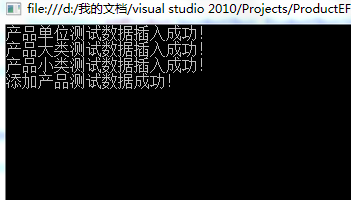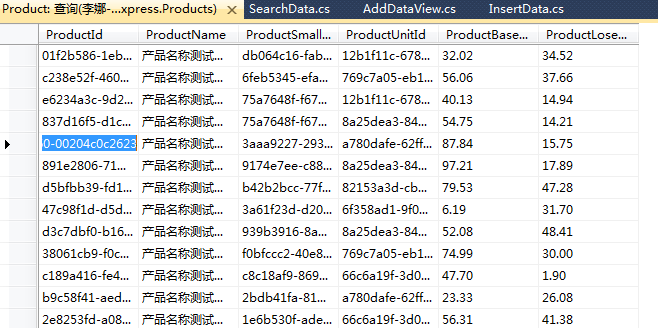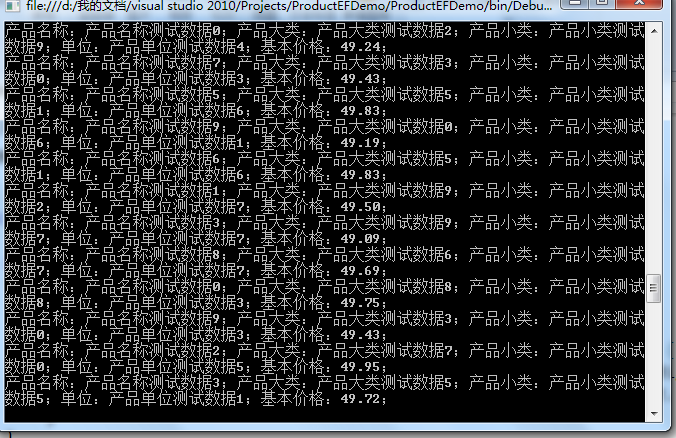参考页面:
http://www.yuanjiaocheng.net/Entity/first.html
http://www.yuanjiaocheng.net/Entity/jieshao.html
http://www.yuanjiaocheng.net/entity/tixijiegou.html
http://www.yuanjiaocheng.net/entity/setenvrionment.html
http://www.yuanjiaocheng.net/entity/createdatamodel.html
上一期博客末尾给出了一个静态类,四个静态方法。这有什么用呢?在继续进行其他内容前,我们先利用这些静态方法为数据库生成基础数据。按照ADO.NET的常规方法,需要先建立连接,创建DataSet或DataReader对象,构造SQL语句,然后执行SQLCommand命令进行作业。现在有了EF,这些步骤全部省掉,EF的内部已经自动实现了这些步骤,我们所要做的只是去调用刚刚定义的几个方法。
在项目上新建一个文件夹,命名为Presenter,用来包含一些与用户交互操作的方法,以便Main函数进行调用。在Presenter文件中下新建一个类,命名为AddDataView.cs,该类就包含一个方法,用以向数据内插入数据:
class="csharpcode">using System; using System.Collections.Generic; using System.Linq; using System.Text; using ProductEFDemo.Business; namespace ProductEFDemo.Presenter { public static class AddDataView { public static void AddAllData() { try { //添加单位数据 InsertData.AddProudctUnit(); Console.WriteLine("产品单位测试数据插入成功!"); //添加产品大类数据 InsertData.AddProductBigType(); Console.WriteLine("产品大类测试数据插入成功!"); //添加产品小类数据 foreach (var productBigType in SearchData.GetAllProductBigType()) { InsertData.AddProductSmallType(productBigType.ProductBigTypeId); } Console.WriteLine("产品小类测试数据插入成功!"); //添加产品数据 foreach (var productSmallType in SearchData.GetAllProductSmallType()) { foreach (var productUnit in SearchData.GetAllProductUnit()) { InsertData.AddProduct(productUnit.ProductUnitId, productSmallType.ProductSmallTypeId); } } Console.WriteLine("添加产品测试数据成功!"); } catch (System.Exception ex) { Console.WriteLine(String.Format("发生错误,错误信息为:{0}",ex.Message) ; } } } }
该类中调用的三个方法:GetAllProductBigType(),GetAllProductUnit(),GetAllProductSmallType()代码如下,由于这些是查询的内容,相关信息后面再详细介绍。
using System; using System.Collections.Generic; using System.Linq; using System.Text; using ProductEFDemo.Models; namespace ProductEFDemo.Business { public static class SearchData { public static List<ProductBigType> GetAllProductBigType() { using (var ctx = new ProductsEntities()) { return ctx.ProductBigType.ToList(); } } public static List<ProductUnit> GetAllProductUnit() { using (var ctx = new ProductsEntities()) { return ctx.ProductUnit.ToList(); } } public static List<ProductSmallType> GetAllProductSmallType() { using (var ctx = new ProductsEntities()) { return ctx.ProductSmallType.ToList(); } } } }
代码没有什么可介绍的,注意有关命名空间的引用。
现在开始调用,在项目的Program.cs的Main方法里调用刚刚定义的AddAllData方法:
using System; using System.Collections.Generic; using System.Linq; using System.Text; using ProductEFDemo.Presenter; namespace ProductEFDemo { class Program { static void Main(string[] args) { AddDataView.AddAllData(); Console.ReadKey(); } } }
注意引用ProductEFDemo.Presenter命名空间。
生成并运行程序,

打开SqlSever Management Studio,展开表,发现数据已经全部插入了:

你猜猜使用上述代码一共生成了多少条Product数据?到目前为止,一句SQL代码都没有写,写的代码都是纯粹的C#代码,而且还有额外的IDE代码提示,是不是很爽?强烈建议不要拷贝代码,而是一行行输入,这样才能感受到书写代码的快乐。
5、数据查询
现在有了数据,就可以随心所欲地进行查询了。这里先对前面调用的GetAllProductBigType(),GetAllProductUnit(),GetAllProductSmallType()作一个解释:
前面三个方法是获取集合性质数据的典型方法,使用的是ToList()扩展方法(关于扩展方法请自已去MSDN查去,我觉得内置的扩展方法就够用了,暂时还不想去自定义!),就可以将实体类的数据进行序列化,成为List范型类,List范型类很好用,可以直接绑定为很多集合类控件的数据源,不管你是用WinForm,还是.Net MVC或是WPF,SIlverlight等,都会广泛地用到,但这超出了我想表达内容的范围,就不赘述了。下面就Linq查询作一介绍。原来我对Linq很抵触,在《C#入门经典》读到这一章的时候,我选择的是跳过,不去看它。后来有时间再翻阅书的时候,惊讶地发现我错过了多么美丽的风景!太简洁,太优雅了!真心感谢微软,推出了这么好用的工具和语法。。。好了,不吹捧微软了,我们还是先来了解一下Linq的基本知识:
所有的的Linq都是引用自System.Linq名称空间的类,因此在使用前要检查是否引用该名称空间,实际上VS在创建类的模板里已经默认添加了这个引用,如果没有请自行添加。
Linq用于查询数据的语法有两种,一种称为查询语法,有点类似于Sql语句,与Sql语句不同的地方是from在前,select在后,from,select,where,distinct,join(注意全部为小写)现在已经成为C#的关键字,专门用于Linq查询,这种方法一般是首选方法,因为它一般更容易理解,但是可惜的是,Linq的全部功能不能由查询语法实现(比如前面的ToList方法在LInq里没有对应关键字),需要借助于另一种语法,称为方法语法,相比而言,方法语法使用起来稍微难理解一点,但是方法语法的优点是比较简洁,代码更优雅。下面两种方法都介绍,可以先用查询语法,熟练以后可以试试方法语法,其实也挺好的!
1)简单查询:场景是这样的,需要从ProductBigType类中查询出包含数字“7”的记录,可以这样写:
using(var ctx=new ProductsEntities()) { var result=from c in ctx.ProductBigType where c.ProductBigTypeName.Contains("7") select c; return result.ToList(); }
如果采用方法语法则可以简化为(为代码简洁起见,后面不再引用using字句):
return ctx.ProductBigType.Where(c => c.ProductBigTypeName.Contains("7")).ToList();
返回的记录是一样的,只不过方法更优雅;
2)数据排序
查询语法使用orderby关键字,如果采用降序,可以添加descending关键字;下面示例的场景是这样的,需要从查询出的所有的ProductBigType中查询出首个单词为“产品”的记录(其实就是全部记录),按降序排序,代码如下:
查询语法:
var result=from c in ctx.ProductBigType where c.ProductBigTypeName .StartsWith("产品") orderby c.ProductBigTypeName descending select c; return result.ToList();
方法语法:
return ctx.ProductBigType.Where(c => c.ProductBigTypeName.StartsWith("产品")).OrderByDescending(c => c.ProductBigTypeName).ToList();
方法语法这种长串的语法称为链式语句,意思像一条长链一样,这是因为所用的方法是扩展方法,都具有相同的类型(实现了IQueryable或IOrderable范型接口),所以可以连接起来;
3)聚合运算符:用于统计数据,与SQL语句中的相关聚合运算符类似,不同之处这些运算符都是扩展方法,首字母必须大写,常用的聚合扩展方法如下:
Count(),表示结果的个数;
Min(),表示结果中的最小值
Max(),表示最大值;
Average(),表示数据结果的平均值;
Sum(),表示求和;
现在我们想要查询出Product表中ProductBaseValue中最大的数据,就可以这样写:
public decimal MaxProductBasePrice() { using (var ctx = new ProductsEntities()) { var result= from c in ctx.Product select c.ProductBasePrice; return result.Max(); } }
或者采用方法语法:
return ctx.Product.Max(c => c.ProductBasePrice);
4)使用导航属性:
昨天博客发表以后,有园友问为什么要用Entity Framework4.x POCO Generator,除了节省力气以外,很重要的一个原因是自已手工写的类经常会忘记导航属性,导致在使用Linq无法导航到所需要的数据,不得不借助join来完成。实际上,Sql的内联Join关键字完全可以少用或者不用(虽然Linq同样提供了jion关键字和Join扩展方法),而采用一个新扩展方法Include来解决内联的问题,可以顺利地完成导航。在使用导航属性进行内联接之前,我们先来看看POCO生成的类:
public partial class Product { #region Primitive Properties public virtual System.Guid ProductId { get; set; } public virtual string ProductName { get; set; } public virtual System.Guid ProductSmallTypeId { get { return _productSmallTypeId; } set { if (_productSmallTypeId != value) { if (ProductSmallType != null && ProductSmallType.ProductSmallTypeId != value) { ProductSmallType = null; } _productSmallTypeId = value; } } } private System.Guid _productSmallTypeId; public virtual System.Guid ProductUnitId { get { return _productUnitId; } set { if (_productUnitId != value) { if (ProductUnit != null && ProductUnit.ProductUnitId != value) { ProductUnit = null; } _productUnitId = value; } } } private System.Guid _productUnitId; public virtual decimal ProductBasePrice { get; set; } public virtual decimal ProductLosePrice { get; set; } #endregion #region Navigation Properties public virtual ProductSmallType ProductSmallType { get { return _productSmallType; } set { if (!ReferenceEquals(_productSmallType, value)) { var previousValue = _productSmallType; _productSmallType = value; FixupProductSmallType(previousValue); } } } private ProductSmallType _productSmallType; public virtual ProductUnit ProductUnit { get { return _productUnit; } set { if (!ReferenceEquals(_productUnit, value)) { var previousValue = _productUnit; _productUnit = value; FixupProductUnit(previousValue); } } } private ProductUnit _productUnit; #endregion #region Association Fixup private void FixupProductSmallType(ProductSmallType previousValue) { if (previousValue != null && previousValue.Product.Contains(this)) { previousValue.Product.Remove(this); } if (ProductSmallType != null) { if (!ProductSmallType.Product.Contains(this)) { ProductSmallType.Product.Add(this); } if (ProductSmallTypeId != ProductSmallType.ProductSmallTypeId) { ProductSmallTypeId = ProductSmallType.ProductSmallTypeId; } } } private void FixupProductUnit(ProductUnit previousValue) { if (previousValue != null && previousValue.Product.Contains(this)) { previousValue.Product.Remove(this); } if (ProductUnit != null) { if (!ProductUnit.Product.Contains(this)) { ProductUnit.Product.Add(this); } if (ProductUnitId != ProductUnit.ProductUnitId) { ProductUnitId = ProductUnit.ProductUnitId; } } } #endregion }
其中ProductUnit和ProductSmallType两个属性就是导航属性,这两个属性就可以在实际使用中进行内连接;
比如我们想在控制台中输出若干条Product记录(这里的搜索条件为ProductBasePrice介于49-50之间),要求显示格式为:产品名称:XXXX;产品大类:XXX;产品小类:XXX;单位:XXX;基本价格:XXX;
就需要通过内联从其他表中获取数据,就要用到前面所说的导航属性。注意到Product表只导航到了ProductSmallType,还需要借助ProductSmallType类导航到ProductBigType。(如果您不明白,还请再回头看有关数据库表的说明)。
这样代码就可以这样写:
public static List<Product> GetProductByPrice() { using (var ctx = new ProductsEntities()) { return ctx.Product.Include("ProductUnit"). Include("ProductSmallType").Include("ProductSmallType.ProductBigType") .Where(c => (c.ProductBasePrice <= 50 && c.ProductBasePrice >= 49)).ToList(); } }
为了实现前面所说的输出,需要在Presenter文件夹中新建一个类,类中有一个方法对相关数据进行处理:
public static class ProductDeatilView { public static void ShowProductDeatil() { foreach (var product in SearchData.GetProductByPrice()) { Console.WriteLine(String.Format("产品名称:{0};产品大类:{1};产品小类:{2};单位:{3};基本价格:{4};", product.ProductName, product.ProductSmallType.ProductBigType.ProductBigTypeName, product.ProductSmallType.ProductSmallTypeName, product.ProductUnit.ProductUnitName, product.ProductBasePrice)); } } }
ShowProductDeatile方法只有一个语句,在调用时就使用了Product类的导航属性,只要你想,可以导航到任何数据,但前提是已经将数据都包容进来了。
现在在Main方法中调用ShowProductDeatile方法,输出结果如下:

这个例子使用查询语法也简单不了多少,因为并没有include关键字可用,也必须要使用Include扩展方法。在此就不举例了。需要注意的是关于Include扩展方法的参数问题,这个参数是导航的路径,必须是一个字母不错的导航属性名,否则会因为查询不到数据而引发异常。如果需要通过导航属性再导航到其他相关的导航属性上,则需要使用点式语法,如上例中对ProductBigType导航属性的引用,就需要使用Include("ProductSmallType.ProductBigType")这样的语法;你也可以试试去掉某一个Include语句,试试会发生什么问题。
这个例子还有一种相对麻烦的实现方法,就是新建一个ProductDepository类,将需要展示出的字段放进去,然后使用Linq的join关键字来进行查询,新建的ProductDepository类:
public class ProductDepository { public string ProductName { get; set; } public string ProductBigTypeName { get; set; } public string ProductSmallTypeName { get; set; } public string ProductUntName { get; set; } public decimal ProductBasePrice { get; set; } }
而查询语句如下:
public static List<ProductDepository> GetProductDepositoryByPrice() { using (var ctx = new ProductsEntities()) { var result = from c in ctx.Product join d in ctx.ProductSmallType on c.ProductSmallTypeId equals d.ProductSmallTypeId join e in ctx.ProductBigType on d.ProductBigTypeId equals e.ProductBigTypeId join f in ctx.ProductUnit on c.ProductUnitId equals f.ProductUnitId where c.ProductBasePrice<=50 && c.ProductBasePrice >=49 select new ProductDepository { ProductName = c.ProductName, ProductBigTypeName = e.ProductBigTypeName, ProductSmallTypeName = d.ProductSmallTypeName, ProductUntName = f.ProductUnitName }; return result.ToList(); } }
调用数据的方法则变为:
public static void ShowProductDeatil() { foreach (var productDepository in SearchData.GetProductDepositoryByPrice()) { Console.WriteLine(String.Format("产品名称:{0};产品大类:{1};产品小类:{2};单位:{3};基本价格:{4};", productDepository.ProductName, productDepository.ProductBigTypeName, productDepository.ProductSmallTypeName, productDepository.ProductUntName, productDepository.ProductBasePrice)); } }
输出的效果是一样的。这种方法虽然比较麻烦,但是当类的关第比较复杂,需要重新梳理时,这不失为一种有效的解决方案,由于类可以无限制扩展,在进行类似WPF或SilverLIght的MVVM模式开发中,可以很方便地将模型与类本身进行分离。但是一般来说,使用导航属性方便的时候,大可不必这么大动干戈,具体怎样取舍,取决于程序的复杂程度。
另外,查询语法的select字句不支持多个字段的语法,因此要想使用多个字段,就必须在查询中创建新对象,可以显示地创建类,也可以创建无名称的对象,术语将这种情况称为投影(projection);使用方法语法也可以进行实现投影,代码如下:
var result=product.Select(c=>new{c.ProductName,c.ProductBasePrice});
声明:本文系本人原创,版权归属作者和博客园共同所有,任何组织或个人不得随意转载,修改。需要转载请与本人联系:qouoww@163.com。